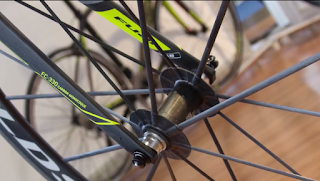Last year, Trek introduced their Emonda SLR 10, declaring it to be the lightest production bike in the world at just 4.65 kilos, or just over 10 lbs. (10.25, to be exact). The frame is a scant 690 grams, or a pound and a half. Selling for around $15,000, it was and still is out of reach for all but the most dedicated and materialistic weight weenies.
 |
| Still crazy a year later. But now it has some competition in the stupid-light stratosphere. |
Damn, it's a sick, sick world.
To wit, the video goes on to say, "Though Fuji does not enjoy the 'cool factor' of other brands, it has shown that you don't need boutique components to spec a 5-kilo build for everyday riding and racing."
 |
| Creative math aside, it's still a stupid-light bike. Er, I mean a bike for "everyday riding and racing." For whom??? |
 |
| The Fuji's Reynolds RZR wheels feature carbon rims, spokes, and even hubs. No worries about durability with these wheels. Nope. Not at all. And remember - those are for "everyday riding and racing." |
 |
| The 665 gram frame is actually lighter than the Trek, so the "extra" weight must come from a 20-gram "porkier" build kit. And you just know that those extra 20 grams equal loads more durability. |
 |
| So that's what an "everyday rider" crank looks like. Actually, a couple of the bikes on this Top 5 list use the same THM carbon crank. Notice those huge openings in that spider. No worries. |
Knocking the Trek Emonda off the pinnacle of lightest production road bike is the Merida Scultura 9000 LTD. Weighing a claimed 4.5 kilos (9.9 lbs.), the company pushes the limits of carbon fiber construction with frame wall thickness of just 0.4 mm in some sections.
 |
| The Merida's 690-gram frame weight pretty well matches that of the Trek, so the additional weight savings must come from more feathery components. No word on pricing. If you have to ask. . . |
Now, all the bikes on this list earn their stupid-light distinction through liberal uses of carbon fiber - in many cases pared down to the limits of the material. I suppose I should point out that stupid-light bikes can be made in any material, including steel and/or aluminum. Remember drillium? That was stupid-light going old-school. Build a steel frame with 0.3 mm wall thickness (yes, tubing was available that thin) and put it under a big American-sized rider, and you might call that stupid-light, too. But knowing the difference in the way carbon fiber fails (usually quickly, with little warning) vs. the way metals fail (usually cracks will be the first signs of impending failure), I just can't see spending so much money for something so potentially temporary.
Watch the video at the BikeRadar site, or right here:
Enjoy! Meanwhile, I need to go use my Proofide inhaler.




great article.
ReplyDeleteI've seen people with not enough funds for some of these stupid-light bikes make stupid things like installing their handlebars and stems with ALLOY bolts and, obviously, crashing hard because of that...
Wagner
Not sure what the last comment meant. My handlebars, stem, seatpost and frame are all made from alloys. Chrome molybdemun is an alloy. So are all the aluminum parts on my bikes. Did Wagner mean aluminum alloy bolts?
DeleteJim
I'm assuming that referred to aluminum alloy bolts, which I have heard can be a bit too light for the task of securing handlebars.
Deletehello Jim.. sorry.. I meant aluminum bolts.. the ones supposed to hold your bottle cages only.. Wagner
DeleteI wouldn't use aluminum alloy bolts except in a very low-stress application--a derailleur pulley bolt, perhaps.
ReplyDeleteWithout evidence that the design engineers sacrificed safety in the name of lightness, these bikes shouldn't be called stupid light. It's sort of an innocent until proven guilty thing.
ReplyDeleteOn the other hand, I wouldn't buy one even if I could afford it, until they had a proven track record of durability. Let people with more money than sense be the guinea pigs.
You're much kinder than I am. I'm sure all these bikes are lab tested to very high standards, and all their computer modeling shows them to be XX-times stronger than steel or aluminum. But I, personally, would never be able to fully trust something that's been designed specifically to push the limits of what's possible with the material in order to achieve the lowest possible weight. "Stupid light" isn't exactly an engineering term - just my opinion.
DeleteEven if those bikes and parts are just as strong as steel or aluminum ones, and I had the money, I wouldn't buy them. Why? Well, for one thing, why would I need them. But more to the point is something Books pointed out: the way carbon fiber fails.
ReplyDeleteA friend of mine is a real weight weenie. He built a hillclimb bike that weights about 7 pounds, 8 ounces. His everyday rider is just over 12 pounds. Picking up a complete bike that weights a little more than 12 pounds is kind of freaky.
ReplyDeleteIt's just hard to imagine a bike that light. Wow!
DeleteRe failure mode: carbon does not fail catastrophically, I have personally experienced broken bike frames, once a chain stay broke on my steel bike and at first I thought I had a rear flat. When I broke a chain stay on my carbon bike I finished the ride not knowing that there was something wrong with the bike. Only after a clean up I discovered the break.
ReplyDeleteHere is a link to a test carbon vs. aluminium https://www.youtube.com/watch?v=xreZdUBqpJs
At the 5 min mark a bunch of them are smashing the frame in to a concrete block and nothing happens.
I don't understand why everybody thinks carbon is the way to get an ultralight bike. Up there in Seattle, Rodríguez bikes are building the "Outlaw" racing bike, that weighs less than 13 pounds with a steel frame. With that weignt, the only advantage a Carbon frame could have would be the aerodynamic profile.
ReplyDeletehttp://www.rodbikes.com/articles/steel-vs-carbon.html